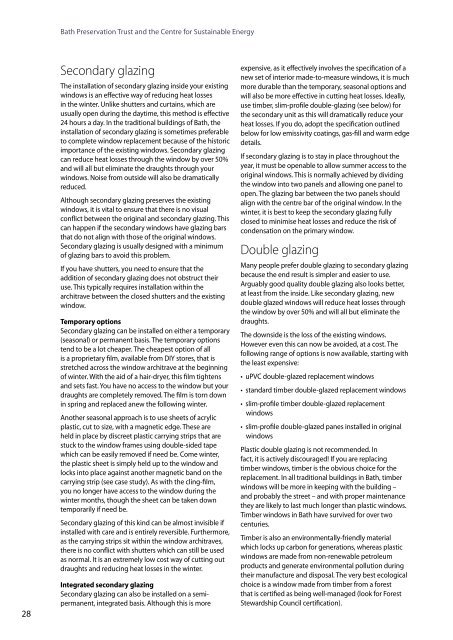Warmer Bath
Create successful ePaper yourself
Turn your PDF publications into a flip-book with our unique Google optimized e-Paper software.
<strong>Bath</strong> Preservation Trust and the Centre for Sustainable Energy<br />
28<br />
Secondary glazing<br />
The installation of secondary glazing inside your existing<br />
windows is an effective way of reducing heat losses<br />
in the winter. Unlike shutters and curtains, which are<br />
usually open during the daytime, this method is effective<br />
24 hours a day. In the traditional buildings of <strong>Bath</strong>, the<br />
installation of secondary glazing is sometimes preferable<br />
to complete window replacement because of the historic<br />
importance of the existing windows. Secondary glazing<br />
can reduce heat losses through the window by over 50%<br />
and will all but eliminate the draughts through your<br />
windows. Noise from outside will also be dramatically<br />
reduced.<br />
Although secondary glazing preserves the existing<br />
windows, it is vital to ensure that there is no visual<br />
conflict between the original and secondary glazing. This<br />
can happen if the secondary windows have glazing bars<br />
that do not align with those of the original windows.<br />
Secondary glazing is usually designed with a minimum<br />
of glazing bars to avoid this problem.<br />
If you have shutters, you need to ensure that the<br />
addition of secondary glazing does not obstruct their<br />
use. This typically requires installation within the<br />
architrave between the closed shutters and the existing<br />
window.<br />
Temporary options<br />
Secondary glazing can be installed on either a temporary<br />
(seasonal) or permanent basis. The temporary options<br />
tend to be a lot cheaper. The cheapest option of all<br />
is a proprietary film, available from DIY stores, that is<br />
stretched across the window architrave at the beginning<br />
of winter. With the aid of a hair-dryer, this film tightens<br />
and sets fast. You have no access to the window but your<br />
draughts are completely removed. The film is torn down<br />
in spring and replaced anew the following winter.<br />
Another seasonal approach is to use sheets of acrylic<br />
plastic, cut to size, with a magnetic edge. These are<br />
held in place by discreet plastic carrying strips that are<br />
stuck to the window frames using double-sided tape<br />
which can be easily removed if need be. Come winter,<br />
the plastic sheet is simply held up to the window and<br />
locks into place against another magnetic band on the<br />
carrying strip (see case study). As with the cling-film,<br />
you no longer have access to the window during the<br />
winter months, though the sheet can be taken down<br />
temporarily if need be.<br />
Secondary glazing of this kind can be almost invisible if<br />
installed with care and is entirely reversible. Furthermore,<br />
as the carrying strips sit within the window architraves,<br />
there is no conflict with shutters which can still be used<br />
as normal. It is an extremely low cost way of cutting out<br />
draughts and reducing heat losses in the winter.<br />
Integrated secondary glazing<br />
Secondary glazing can also be installed on a semipermanent,<br />
integrated basis. Although this is more<br />
expensive, as it effectively involves the specification of a<br />
new set of interior made-to-measure windows, it is much<br />
more durable than the temporary, seasonal options and<br />
will also be more effective in cutting heat losses. Ideally,<br />
use timber, slim-profile double-glazing (see below) for<br />
the secondary unit as this will dramatically reduce your<br />
heat losses. If you do, adopt the specification outlined<br />
below for low emissivity coatings, gas-fill and warm edge<br />
details.<br />
If secondary glazing is to stay in place throughout the<br />
year, it must be openable to allow summer access to the<br />
original windows. This is normally achieved by dividing<br />
the window into two panels and allowing one panel to<br />
open. The glazing bar between the two panels should<br />
align with the centre bar of the original window. In the<br />
winter, it is best to keep the secondary glazing fully<br />
closed to minimise heat losses and reduce the risk of<br />
condensation on the primary window.<br />
Double glazing<br />
Many people prefer double glazing to secondary glazing<br />
because the end result is simpler and easier to use.<br />
Arguably good quality double glazing also looks better,<br />
at least from the inside. Like secondary glazing, new<br />
double glazed windows will reduce heat losses through<br />
the window by over 50% and will all but eliminate the<br />
draughts.<br />
The downside is the loss of the existing windows.<br />
However even this can now be avoided, at a cost. The<br />
following range of options is now available, starting with<br />
the least expensive:<br />
• uPVC double-glazed replacement windows<br />
• standard timber double-glazed replacement windows<br />
• slim-profile timber double-glazed replacement<br />
windows<br />
• slim-profile double-glazed panes installed in original<br />
windows<br />
Plastic double glazing is not recommended. In<br />
fact, it is actively discouraged! If you are replacing<br />
timber windows, timber is the obvious choice for the<br />
replacement. In all traditional buildings in <strong>Bath</strong>, timber<br />
windows will be more in keeping with the building –<br />
and probably the street – and with proper maintenance<br />
they are likely to last much longer than plastic windows.<br />
Timber windows in <strong>Bath</strong> have survived for over two<br />
centuries.<br />
Timber is also an environmentally-friendly material<br />
which locks up carbon for generations, whereas plastic<br />
windows are made from non-renewable petroleum<br />
products and generate environmental pollution during<br />
their manufacture and disposal. The very best ecological<br />
choice is a window made from timber from a forest<br />
that is certified as being well-managed (look for Forest<br />
Stewardship Council certification).


